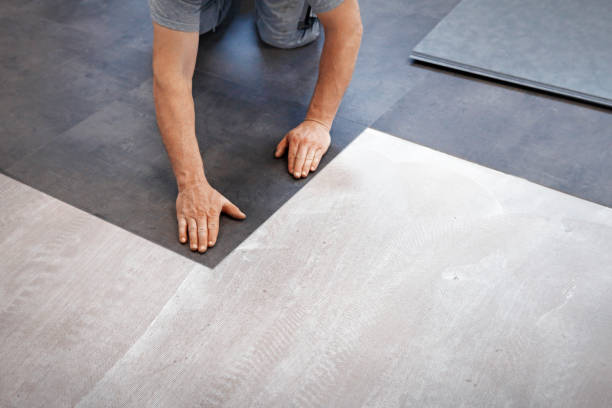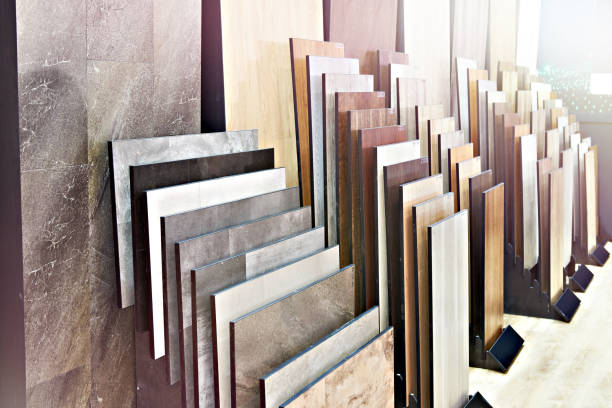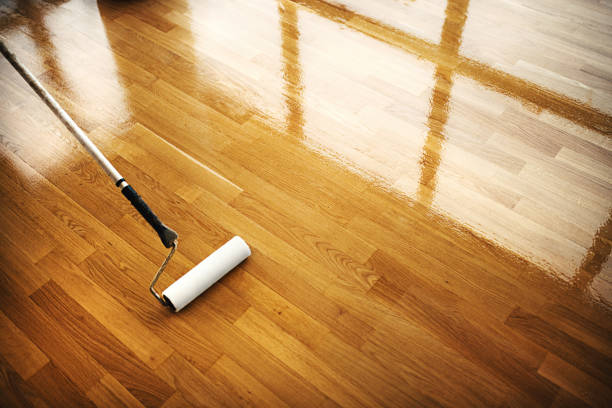Finding the perfect floor covering is a fundamental decision and the variety of materials is huge. In addition to classic floor coverings such as wooden floors, parquet, or tiles, high-quality vinyl floors are particularly popular. And there are countless sales arguments that even convince “vinyl skeptics”. Therefore use our tips for laying vinyl floors.
What are vinyl floors anyway?
With the many names of synthetic floors, consumers can quickly lose perspective. Today’s vinyl floor is a further development of the legendary PVC covering and is made on the basis of polyvinyl chloride. The certified vinyl products do not contain any harmful substances. They are therefore harmless from a health and ecological point of view. It is also flexible, waterproof, and pleasantly warm.

Furthermore, the invisible surface sealing ensures high durability. Consequently, you don’t have to worry about scratching the floor when vacuuming, for example. But vinyl flooring is also unbeatable in terms of design, functionality, feel hygiene, comfort, durability, and price. Living rooms, bedrooms, bathrooms, kitchens, hallways, and children’s rooms are possible areas of application. In addition, the modern floor characterizes the interior design of commercial and public spaces.
What is the difference between vinyl floors?
There is a suitable product for every requirement and every interior design! There are different vinyl floors to choose from in hardware stores such as Toom. These differed from each other in size, color, thickness, and appearance. There are also three types of laying: full-surface bonding, loose laying, and floating laying. Before renovating or relocating, seek advice from specialist staff. Because, for example, there are products that are ideal for damp rooms, living rooms, or underfloor heating.
What tools do you need to lay vinyl flooring?
What you need to successfully lay vinyl flooring is the following accessories:
- vinyl flooring
- vinyl glue
- sticky roll
- cutter knife
- folding rule
How do you lay a vinyl floor correctly?
Laying the vinyl floor is quite simple and easy to do even for laypeople. In addition, it saves costs. And with a little preparation, renovating is a lot of fun. The laying work can be carried out alone or ideally in pairs.
Let’s start with the preparations
- First, determine the exact amount of material. To do this, calculate the length of the room times the width of the room plus 10 percent waste. Take into account niches, radiators, window fronts, door frames, heating pipes, or similar. Calculation example: 5 m long x 4 m wide = 20 m2 + 10% waste = 22 m2
- Then clean the floor thoroughly. If necessary, remove the old covering completely. Repair any damage or unevenness with repair mortar or leveling compound. To ensure that the floor is smooth and level, and the sub-floor if necessary. Finally clean again.
- Roll out or deposit the covering in a warm place. This allows it to acclimatize and then be easy to process.
- Tip: Use a spirit level to determine unevenness!
1st step
After the obligatory preparation, complete the layout and align the floor with new plastic covering. Cut the protruding covering in the corners at an angle with the knife, this allows the vinyl to be better adjusted. If necessary, shorten the overhangs on the walls to five centimeters with the cutter knife. Then let the topping rest for a day.
2nd step
Then carefully fold one half of the covering back to the middle of the room. Make sure that the covering does not shift. Next, apply the finished adhesive evenly to the clean floor using the adhesive roller. Then let the glue set for about 15 minutes. Then fold back the floor covering and smooth the glued surface with the metal roller. But be careful: avoid bubbles and wrinkles!
3rd step
Now do the same with the other half of the topping.
4th step

Now the trimming and trimming with the craft knife begins. A distance of about five millimeters to the wall is planned here. The reason for the addition is that depending on the temperature, vinyl can expand or contract.
5th step
Attach baseboards and transition profiles that match the finish. The living room or bathroom renovation project is ready!
The current vinyl flooring trends
Statement instead of standard! In addition to classic vinyl flooring, LVT design floors are very popular for interior design. The name LVT stands for luxury vinyl tiles. The exclusive “Bodenschatz” imitates concrete, tiles, parquet, carpet, or wooden floors in a deceptively real way. Furthermore, the original colors or structures of the imitated objects can be clearly seen and felt on the surfaces. The chic designer floors are currently very trendy as wall coverings. Thanks to the seamless installation, kitchens, and bathrooms get a super-modern style – and unsightly mold and limescale deposits will never appear again. The new “super floor” corresponds to the zeitgeist and fulfills all wishes!


